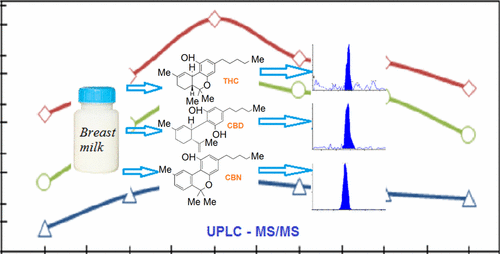Testing breast milk for cannabinoids

With the legalization of medical and recreational marijuana spreading across the country, the drug's use is reportedly increasing among pregnant women. It stands to reason that many of these women will continue to use marijuana after they give birth. Now researchers have developed a new method to help determine what this means for infants' potential exposure to the active compounds in marijuana in breast milk. Their report appears in the journal ACS Omega.
Cannabinoids, marijuana's active compounds such as tetrahydrocannabinol (THC) and cannabinol, like to stick to fat, which is abundant in breast milk. This stickiness suggests that in women who use marijuana, these compounds can end up in breast milk, raising concerns about their potential effects on nursing babies. But the health risks to these infants largely remain undetermined. This is partly due to researchers' limited ability to precisely measure marijuana's active compounds in milk. Current analytical methods can detect THC at levels of 1.5 nanograms per milliliter or higher, but no current method can measure cannabinol or cannabidiol in milk.
Researchers at the Centers for Disease Control and Prevention developed a method that begins with saponification—a process often associated with soap-making—to separate cannabinoids from fat in milk. With this approach, the team can detect trace levels (picograms per milliliter) of active marijuana compounds, including cannabinol and cannabidiol, that they say could be present in milk due to second-hand exposure. The test is 100 times better at detecting THC in milk than previous techniques. The researchers say that their approach could contribute to future studies designed to determine potential health risks of a mother's marijuana exposure to her breastfeeding infant.
More information: Binnian Wei et al. Sensitive Quantification of Cannabinoids in Milk by Alkaline Saponification–Solid Phase Extraction Combined with Isotope Dilution UPLC–MS/MS, ACS Omega (2016). DOI: 10.1021/acsomega.6b00253
Abstract
Maternal exposure to marijuana during the lactation period—either active or passive—has prompted concerns about transmission of cannabinoids to breastfed infants and possible subsequent adverse health consequences. Assessing these health risks requires a sensitive analytical approach that is able to quantitatively measure trace-level cannabinoids in breast milk. Here, we describe a saponification–solid phase extraction approach combined with ultra-high-pressure liquid chromatography–tandem mass spectrometry for simultaneously quantifying Δ9-tetrahydrocannabinol (THC), cannabidiol (CBD), and cannabinol (CBN) in breast milk. We demonstrate for the first time that constraints on sensitivity can be overcome by utilizing alkaline saponification of the milk samples. After extensively optimizing the saponification procedure, the validated method exhibited limits of detections of 13, 4, and 66 pg/mL for THC, CBN, and CBD, respectively. Notably, the sensitivity achieved was significantly improved, for instance, the limits of detection for THC is at least 100-fold more sensitive compared to that previously reported in the literature. This is essential for monitoring cannabinoids in breast milk resulting from passive or nonrecent active maternal exposure. Furthermore, we simultaneously acquired multiple reaction monitoring transitions for 12C- and 13C-analyte isotopes. This combined analysis largely facilitated data acquisition by reducing the repetitive analysis rate for samples exceeding the linear limits of 12C-analytes. In addition to high sensitivity and broad quantitation range, this method delivers excellent accuracy (relative error within ±10%), precision (relative standard deviation <10%), and efficient analysis. In future studies, we expect this method to play a critical role in assessing infant exposure to cannabinoids through breastfeeding.
Provided by American Chemical Society

















